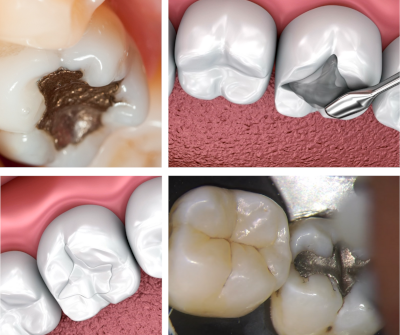
Amalgam Fillings it is more resistant than other composites with a light colour.
The dentist will remove the cavity to prevent damage in the vital dental structures .
Then restore the tooth using a composite or amalgam .
The filling will occur in cases of accidental fracture caused by a sudden blow or the chewing of hard foods.
For aesthetical corrections, tooth filling is widely used to restore an ideal appearance or help to improve the colour.
Fillings allow for the restoration of the damaged area of a tooth and recovery of its anatomical shape, masticatory function, and aesthetical features.
Amalgam Fillings
Amalgam fillings originated in the USA approximately two hundred years ago. Over the years, it was subjected to improvements in order to be more effective for dentistry.
Eventually, it became popular due to its dark colour.
In Portugal, it is called ‘chumbo’ (lead). Therefore, there are a lot of people in Portugal who still say that they are going to ‘lead’ their teeth. In fact, its composition does not include lead. It mainly has high percentages of silver from approximately 40% to 75%.
The composition of amalgam includes silver, copper, and another element called mercury, which, together with the others in the form of a powder, will comprise a metallic and greyish paste. This thick and compact paste is sold in capsules.
In which cases is amalgam used?
It is widely used for the back teeth, such as the pre-molars and main molars. Due to its dark colour, if the teeth are more visible, they will be treated with a composite of a light colour, similar to natural teeth.
It is used to coat non-visible teeth such as the back teeth.
Amalgam Advantages in Dental Restorations (Fillings)
It is more resistant than other composites with a light colour.
The increased dental restoration resistance will also increase its lifespan. Therefore, it will remain intact in your mouth for an extended period of time. It is more resistant to the masticatory function.
In addition, amalgam is more resistant to cold or heat due to a greater coefficient of expansion and contraction that is similar to a natural tooth.
Amalgam Disadvantages in Restorations (Fillings)
- The dark colour is less pleasant.
- It may trigger allergic reactions, which may also happen with other dental restoring materials.
Controversy Regarding the Use of Mercury
In recent years, we have heard a lot of things about mercury and its possible toxicity to the human body. There have been reports in newspapers and other media. The truth is there is no evidence about the harmfulness of amalgam regarding its use in dentistry.
The World Health Organisation considers amalgam to be susceptible and harmful to human health if applied with doses above 170 to 285 micrograms per day. If mercury release occurs during a filling, the dosage would not be above 1 to 5 micrograms, which is an extremely smaller value to the one mentioned previously.
In recent years, research has been conducted in Portugal, Europe, and the United States including children aged 6 to 10 that had dental treatments with this material. These studies revealed no neurological effects on the children treated with mercury or others treated with resin composites.
Mercury is also used in completely different situations and contexts such as thermometers and blood pressure gauges. The mentioned devices were produced with mercury . Due to its high concentration, it has been proven to be harmful to the environment.
This happens because the material can be wrongly placed in landfills and groundwater, which will transfer it to rivers and seas. As a consequence, this element will mix with fish feed and may cause adverse changes in the health of those who consume these fish.
Scientific sources and studies:
Reviewed by VitaCentre Dental Clinic Staff on May 8, 2025

